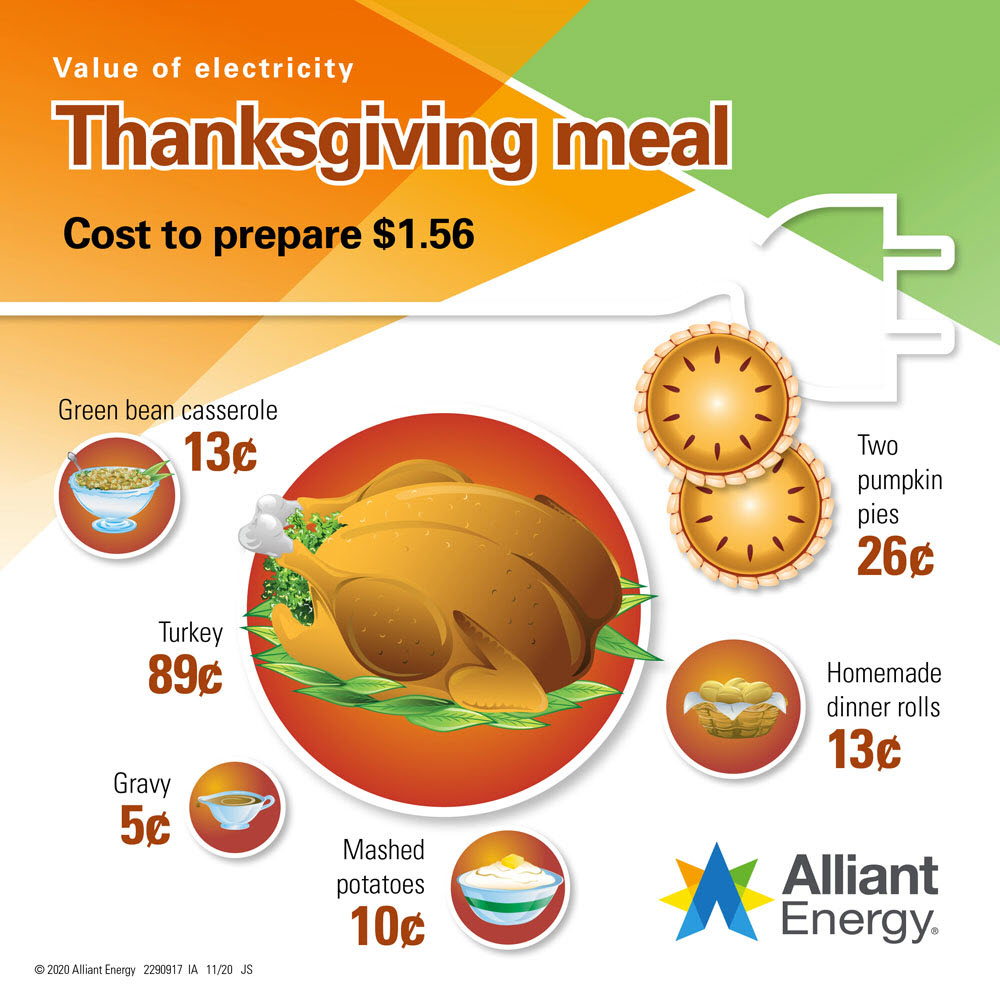Alliant Energy news release
Energy is among least expensive ingredients on the Thanksgiving menu
Ten tips to be more energy efficient in the kitchen
CEDAR RAPIDS, Iowa – November 16, 2020 – Traditional holiday gatherings may have a whole new look this year due to the coronavirus. But cooks across the Midwest will still rely on one universal ingredient – energy. When compared to the other necessary ingredients for the holiday meal, energy remains one of the lowest cost items.
“Although there may be fewer friends and family at your table this Thanksgiving, the value you get from safe, reliable and affordable electric or natural gas remains the same,” said Linda Mattes, Alliant Energy’s Vice President for Customer Operations. “We’re proud to power whatever celebration you have this year. On behalf of our employees, we wish everyone a joyful Thanksgiving and encourage you to gather as safely as possible.”
For Alliant Energy’s customers, the average cost to cook Thanksgiving dinner is $1.56 when using electricity, and $0.37 with gas appliances.
| thanksgiving meal | electricity cost (avg.) |
natural gas cost (avg.) |
|---|---|---|
|
16 lb. stuffed turkey roasted in an oven for 3.5 hours
|
$0.89 | $0.22 |
|
Pan of mashed potatoes cooked on the stove for 20 minutes
|
$0.10 | $0.02 |
|
Gravy cooked on the stove for 10 minutes
|
$0.05 | $0.01 |
|
Dinner rolls baked in the oven for 30 minutes
|
$0.13 | $0.03 |
| Green bean casserole baked in an oven for 30 minutes | $0.13 | $0.03 |
| Two pumpkin pies baked in an oven for one hour | $0.26 | $0.06 |
| Total energy cost | $1.56 | $0.37 |
There are also simple changes that customers can make as they prepare their holiday meal to better control their energy use.
10 Tips to make your holiday meal more energy efficient:
- Let the furnace rest. Your holiday cooking will likely heat up the house. Turn your thermostat down three to five degrees to save energy and you’ll still be comfortable.
- Skip the preheat. The turkey is traditionally stuffed early in the morning and roasted for hours. When cooking meats or dishes for several hours, there is no need to preheat your oven.
- Use glass or ceramic pans. They heat faster than metal pans, and you can lower the temperature by 25 degrees, reducing energy use.
- Electric stovetops can only transmit heat to items they’re in direct contact with. Keep pots and pans centered over the burner and consider replacing “wobbly” or warped cookware.
- Cooking together saves energy. Cook as much of your meal at one time as possible. Foods with different cooking temperatures can be cooked together, if the temperature difference is less than 25 degrees.
- Close the oven door. Resist the urge to open the oven door and check the meal. Each time you open the door, it will decrease the temperature inside by 25 degrees. This means your oven has to use more energy to stay on temperature. If you need to check on a dish, use the oven window instead.
- Coast to the finish. Food keeps cooking even after you turn off the burner. When food is almost ready, turn off the oven or burners and let existing heat finish the cooking for you.
- Don’t overlook microwaves, multicookers, crockpots, air fryers and toaster ovens. They all use about half the energy of a conventional oven.
- Clean while it’s hot. If your oven needs a self-cleaning cycle, do it while the oven is still hot.
- Run a full load in the dishwasher and you will use less hot water than doing dishes by hand.
For more ways to be more energy efficient, check out the Save at Home, Stay at Home section at alliantenergy.com/stayhome.

